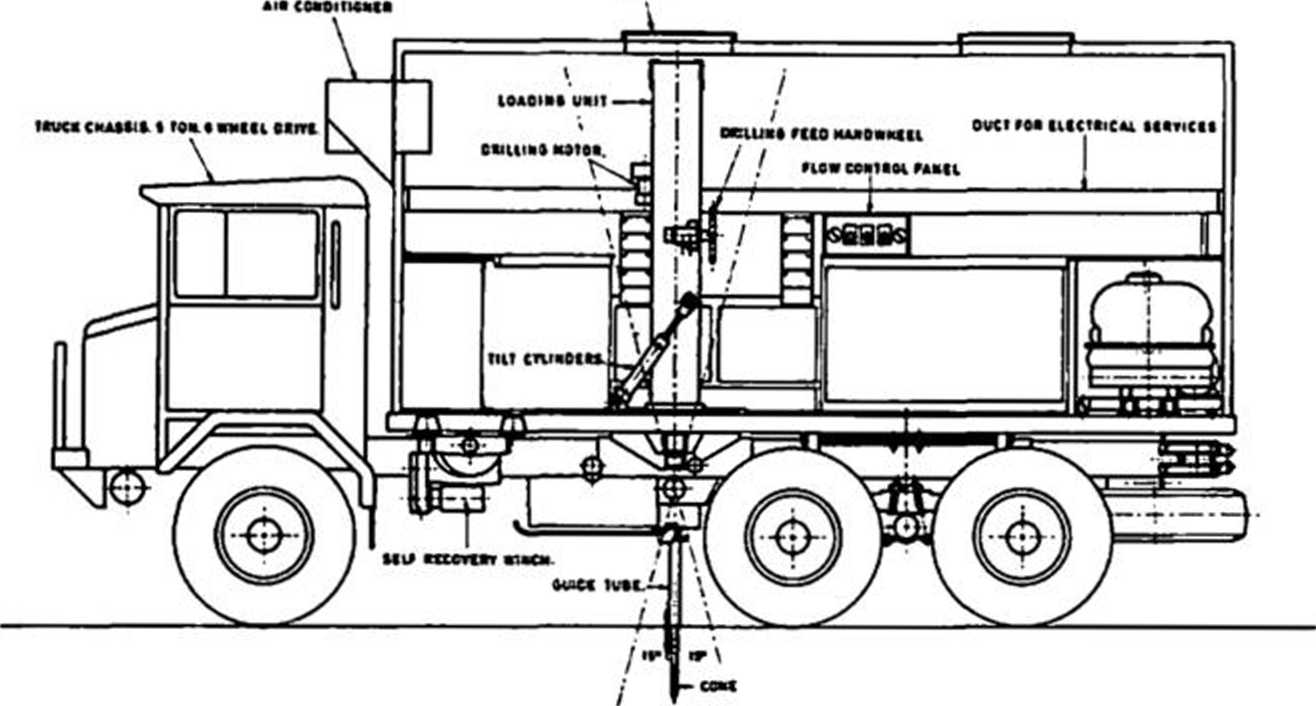6585844961
Australia
havc«

FIG.3
C.R.B. Penetrometer Test Ing Vehlcle
of tha Fugro type penetrometer In sands has been undertaken by HOLOEN (1971), VEISMANIS (1974) and CHAPMAN (1974).
The thrust machlnes malnly comprlse the well-known Dutćhmachlnes (SANOLERAT, 1972, Fig. 6 and 9) of 2,500 and 10,000 kg capaclty and varlous drlll riga.
The Country Roeds Board of Victorla has developed a testlng vehlcle, shown In Figurę 3. Its features include an Army-deslgned, 8-wheel drlve truck; 20,000 kg capaclty; tlltlng loadłng unit; aut ornat ic rod screwing and unscrewlng; and a drl IIIng functlon to borę through hard layers.
5.2 Technięuea
With one exceptlon, all testera penetrate at a ratę In the rangę specified In the proposed A.S.T.M. Standard Method - vlz., 1 to 2 cm/sec.
With the exception of one tester that uses a provlng ring, all use hydraullc load cells to measure the penetration re ais tan ces of mechanical penetrometers.
The pressure gage readlngs at preselected depth lntervals (malnly 15, 20, or 30 cm) are recorded manually and later converted to penetration resistances, which are usually presented graphically as resistance versus depth.
Since 1968, the Country Roads Board of Vlctorla (BARTLETT and HOLDEN, 1988, Discusaions) have recorded the slgnals from thelr electrlcal frlction cone penetrometers with a data logger connected to a chart recorder and a punched paper tape output, The data on tape is then procesaed by a Computer that calculates cone and frlction resistances, frlction ratlo, and cumulatlve skin frlction, and plots the flrst three against depth.
5.3 Use of C.P.T. Results
Most organisatlons that possess quasl-statlc C.P.T. equlpment use the penetrometer as a design tool. It Is used eąually for design (44%) and exploratory purposes (44%) with some use (12%) for the control of malnly compaction processes.
Only four organisatlons calculate the frlction ratlo, for the prime purpose of Indlcating the materiał type.
Apart from thelr important use In extrapolating laboratory test data (obtalned on sampłes taken from a borehole) across a job site, C.P.T. results are used directly In the eslimatlon of (i) (he shear strength of clays for such uses as rough prelimlnary stablllty analyses; (li) ssttlements on sands and also multl-layered deposlts (THORNE and BURMAN, 1968); and (Ili) load capacitle8 of plles. The major references consulted for design methods are the paper by THORNE and BURMAN (1968) and the book by SANOLERAT (1972). Settlements In sands are most accurately determlned uslng the C.P.T. in conjunction with the straln influence factor method proposed by SCHMERTMANN (1970), which appears to be galnlng In favour.
6. OTHER TYPES OF PENETRATION TEST
Mo3t of the other types of penetration tests used in Australia would come Into the category of Mcontinuous dynamie tests*. Unforlunately, many of the replles simply stated “Dynamie Cone Test* without glving any detalls.
6.1 Contlnuous Dynamie Tests
There are at least nlne types of contlnuous dynamie test havingdifferent cone diameters, rod slzes, hammer weights and helghts of fali. In many cases, the penetrometer is used simply as a probe to determine the thickness of a soft soli layer or the depth to rock.
The most popular dynamie test for shallow foundatlon investlgatlons is the manuał teBt developed at the Country Roads Board of Vlctoria by SCALA (1958) or the modlfłed verslon descrlbed by GLICK and CLEGG (1965) - see Figurę 4. The callbratlon of the modified Scala penetrometer (ibid.) in a Perth Sand • as charts of penetration resistance (blows/ft) versus relative denslty - fonns the basis for interpreting Its test results.
A test sometimes employed in deep foundatlon inyestigatłons uses the S.P.T. equlpment with a 2 in. (50.8 mm) diam., 60° cone driven in a contlnuous manner from the surface. Applying In-house experience. the test results are often used to estimate
Wyszukiwarka
Podobne podstrony:
P5140008 Properties of Kinesio Tex Tape Skin Preparation Selection of Kinesio Strip Type Kinesio Tex
Zdjęcie065(5) Fig. 4. Schemacie model for formation of che Zcchstein polymeullic mincralizaiion in »
SUMMARY The structure of the library collection of Voivodeship Public Library in Opole has been char
64 (47) ISTQB Advanced Level - Test Manager sample exam - wersion 2012Pytanie 64 z 65 One person has
microwat flasher Microwatt L.E.D. Flasher ■MdkisfbEg The Circuit of Fig3 is a complementary relaxati
DSCF0013 3Gustav Adolf and the Art of War1 Until very recent times it has been a sound generalizatio
New Forms Taschen 177 American Dreams Peter Eisenman, once a member of the so-called "New York
Slajd56 Bielactwo Fig. 1.3-2.8 Bila te rai segmental vitiligo of the same distri>ution in Asian{a
00044 d562ea1ca0756aca314d95625d46970 43A Rule-Based Approach to Multiple Statistical Test Analysis
Slajd56 Bielactwo Fig. 1.3-2.8 Bila te rai segmental vitiligo of the same distri>ution in Asian{a
Fig. 3. Behavior of CO and C02 conceniration in the stack gases as a function of stoichiometric raii
K. Gródecki Rys. 2. Rysunek obrazujący odejmowanie tła. Fig. 2. Graph presenting the subtraction of
Level 3 Model ExamREADING Description of the Test The test consists of 3 tasks containing 20 questio
1 100 000 Ryc. 10. Typy siedliskowe lasu w granicach opracowania Fig. 10. Forest habitat typcs of th
14 Joanna Rakowska Fig. 5. Fig. 5. Ranking of voivodships by their share in total EU funding obtaine
więcej podobnych podstron